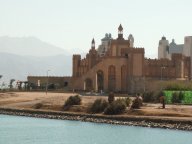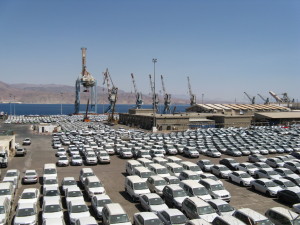With a population of 48,000 people, Eilat is part of the Southern Negev Desert, at the southern tip of the Arava, adjacent to the Egyptian village of Taba to the south, the Jordanian port city of Aqaba to the east, and within sight of Saudi Arabia to the south-east, across the gulf.
The city’s beaches, coral reef, nightlife and desert landscapes make it a popular destination for domestic and international tourism.
The area was designated as part of the Jewish state in the 1947 UN Partition Plan. The Arab village of Umm Al-Rashrash was taken without a fight on 10 March 1949, as part of Operation Uvda.
 The Timna Copper Mines near Timna valley were opened, a port was constructed, the Eilat Ashkelon Pipeline laid, and tourism began.
The Timna Copper Mines near Timna valley were opened, a port was constructed, the Eilat Ashkelon Pipeline laid, and tourism began.
Construction of the city and the Port of Eilat began shortly after the end of the war. The port became vital to the fledgling country’s development. After the 1948 Arab–Israeli War, Arab countries maintained a state of hostility with Israel, blocking all land routes. The only access to trade with the rest of the world was by air and sea. In addition, Egypt denied Israeli-registered ships passage through the Suez Canal, which was later extended to ships bound to and from Israeli ports. This made Eilat and its sea port crucial to Israel’s communications, commerce, trade, and oil imports.
In 1956 and again in 1967, Egypt’s closure of the Straits of Tiran to Israeli shipping effectively blockaded the port of Eilat. In 1956, this led to Israel’s participation alongside Britain and France in the war against Egypt sparked by the Suez Crisis, while in 1967 it was cited by Israel as an additional casus belli leading to the outbreak of the Six-Day War.
Following peace treaties signed with Egypt in 1979 and Jordan in 1994, Eilat’s borders with its neighbors were finally opened.
Future development plans
In July 2012, Israel signed an agreement with China to cooperate in building the high-speed passenger and freight railline to Eilat, and will link Eilat with Beersheba and Tel Aviv.
There are additional plans to dismantle the Eilat Airport, in favor of the planned Timna Airport, and develop the area. The site is planned to contain over 2,100 hotel rooms and 1,000 apartments. The site will also contain 275 dunams (approx 70 acres) of public space and pedestrian paths. The plans also set aside space for the railway line and an underground railway station.
All these projects are part of a plan to turn Eilat into a metropolitan area of 150,000 people and 35,000 hotel rooms.
Great Things To Do in Eilat
- Birdwatching and ringing station: Eilat is located on the main migration route between Africa and Europe. International Birding & Research Center in Eilat.
- Camel tours.
- Freefall parachuting.
- Visit all the parks and nature reserves
- Go to the beach
Great Eilat Links
- Coral Beach Nature Reserve – An underwater marine reserve..
- Coral World Underwater Observatory – An observatory with aquaria, a museum, simulation rides, along with shark, turtle and stingray tanks.
- Dolphin Reef – A marine biology and research station where visitors can swim with dolphins.
- Hai-Bar Yotvata Nature Reserve – Conserves endangered and biblical species.
- Eilat Airport
- IMAX Cinema
- Kings City – A biblical theme park.
- What’s Up Observatory


